Aníbal Sánchez Is What the Nationals Have in Game 1
The Nationals rotation is headed by Max Scherzer with fellow aces Stephen Strasburg and Patrick Corbin falling neatly in line. Yet, when the Nationals take on the Cardinals tonight, Aníbal Sánchez will get the start. A hard-fought Division Series against the Dodgers saw Scherzer and Strasburg start the fourth and fifth games of the series with Corbin pitching in relief on Wednesday. With those three unavailable, Washington turns to their fourth starter in Sánchez.
Sánchez, who put up a six-win season with the Tigers in 2013, developed some home run issues from 2015 through 2017 before having a bounceback season in 2018 that continued into this year, as he’s been a solid, slightly above-average starter. He’s lost about three mph off his fastball since his career year, but he throws a mix of pitches to keep hitters off balance. He has three offerings he uses most of the time in a 90-mph four-seam fastball, a slow change, and a cutter. He also mixes in a splitter, and he got two strikeouts using that pitch against the Dodgers (both against Russell Martin). He throws the fastball outside to both lefties and righties. While Sánchez throws the change more often against lefties, he does use it a decent amount to come inside against righties, and that pitch is the 35-year-old’s only real swing-and-miss offering. Against the Dodgers, Sánchez got five strikeouts on the change, including this one against Cody Bellinger.
The four-seam fastball usage bodes well for the Cardinals, in theory, as they have feasted on the pitch all season long. However, the Cardinals have put up terrible numbers against both the cutter and the change. Potentially providing more trouble, the Cardinals won’t be able to try and get ahead in the count and expect the fastball, as Sánchez’s usage of the pitch actually goes down when he’s behind in the count. The righty threw his four-seam fastball in a 0-0 count 42% of the time this season, so if the Cardinals are going to look for that fastball, it needs to happen on the first pitch. Read the rest of this entry »

